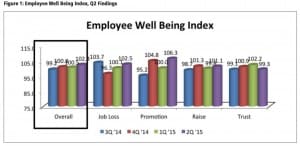The top five findings from the second quarter’s Employee Well Being Study.
By The Editors
HRO Today magazine has partnered with Yoh Recruitment Process Outsourcing for the Employee Well Being Study, which provides an index to measure United States employment security. According the Bureau of Economic Analysis (BEA), approximately 70 percent of the U.S. Gross Domestic Product is for household final consumption expenditure. This measure is the market value of all goods and services purchased by households. Since the perception of job security greatly impacts purchasing behavior, there is a need to focus on the perceptions around an individual’s job outlook.
The focus of the Employee Well Being Study is measuring perceived employment security, not the more macroeconomic indices such as the Bureau of Labor Statistics Unemployment rate, Gallup’s Economic Confidence Index, BLS Job Openings, and Labor Turnover Survey (JOLTS) or United States Consumer Sentiment.
In order to derive its metrics, HRO Today magazine employs ORC International’s CARAVAN® Omnibus Surveys. Approximately 333 interviews are conducted online on a monthly basis among those aged 18 years and up, working full time in the U.S. This data is then compiled into quarterly reports.
Respondents are asked a total of four questions on involuntary job loss possibility, likelihood of promotion, anticipation of a raise of at least 3 percent, and trust in company leadership.
Findings from the second quarter of 2015 reveal five interesting trends:
The Employee Well Being Index increased between the first and second quarters of 2015, up from 100.5 to 102.3. This uptick suggests a minor growth in employees’ faith in their employment situation, and mirrors the unemployment rate drop to 5.3 percent. There were jumps in optimism in three of the four areas examined: job loss, promotion potential, and raise potential.
Females are the most confident in their job security. In fact, about 50 percent fewer female respondents report concern over losing their jobs in the next 12 months than their male counterparts. While all groups examined felt generally more positive about job security in the second quarter of 2015 over the first quarter, minorities and the young trail in perceptions of employment well being. Interestingly, both those that are the lowest paid and the highest paid are the least secure in their job security.
There is an increase in the belief in a promotion from current employer in the next 12 months, up to 20.3 percent from 18.7 percent in the prior quarter. Males continue to be more optimistic than females, though the gap narrowed to 5.1 points, the smallest it’s been. The report showed 22.9 percent of males indicated they felt they’d receive a promotion versus 17.8 percent of females.
Minorities showed more optimism than whites in getting a promotion by a ratio of three to one. Again there’s an inverse relationship between the increased likelihood of a promotion and getting older. This is likely because as an employee ages and advances in their career, there are fewer opportunities for promotion.
Just more than one-quarter (27.6 percent) of respondents feel they’ll get a raise of at least 3 percent after their next review, which is very steady over the last four quarters. But the gap is widening between rich and poor. As income increases, so does the belief in the likelihood of a raise. Those with at least $100,000 annual household income are the most inclined to think they’ll get a raise, while those making under $35,000 are least optimistic.
The study also shows that as age increases, the belief there will be a raise of at least 3 percent after the next review declines steadily. As employees get older, they feel that what they make today is about what they’ll make tomorrow.
Most employees don’t have trust in their company’s leadership. Overall, less than one half (42.9 percent) of respondents trust company leadership to make sound decisions in the second quarter of 2015, a slight decline from the prior quarter. The study’s trends show that that as age increases, trust in a company’s leadership erodes more and more. The groups with the least trust are female, the oldest, least educated, and lowest incomes. Whites are the ethic group with the lowest trust in company leadership, despite generally higher education and income than other groups. Perhaps cynicism drives the opinion.
A full copy of the report can be downloaded at: www.hrotoday.com/category/market-intelligence/ research/.















